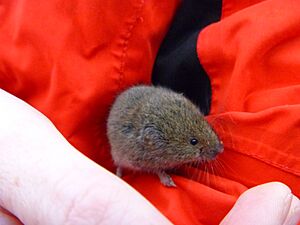Bavarian pine vole facts for kids
Quick facts for kids Bavarian pine vole (Microtus bavaricus) |
|
|---|---|
 |
|
| Conservation status | |
| Scientific classification | |
| Genus: |
Microtus
|
| Species: |
bavaricus
|
The Bavarian pine vole (Microtus bavaricus) is a small rodent, a type of vole, found in the Alps mountains of Austria, Italy, and Bavaria (a part of Germany). These voles like to live in wet meadows, usually at high places between 600 and 1,000 meters above sea level.
A Survivor from the Ice Age
This special vole is a true survivor! During the last Ice Age, which ended many thousands of years ago, the Bavarian pine vole managed to live through the cold. It found safe spots, called glacial refuges, including some in the Northern Alps.
Rediscovery and Conservation
For a long time, people thought the Bavarian pine vole might be extinct. Scientists only had 23 old museum specimens of this species. The last time one was seen was in 1962. It was known to live in just one place, Garmisch-Partenkirchen in Bavaria. This area was changed when a hospital was built there in the 1980s.
But then, something amazing happened! In the year 2000, a group of these voles was found. They were discovered in Northern Tyrol, which is just across the border from Germany in Austria. This was a huge surprise and a great discovery!
In 2010, another study found what seemed to be Bavarian pine voles in Slavonia, Croatia. This was far from their known homes in Austria or Germany. Scientists think that competition with other animal species might have changed where these voles live.
An Austrian scientist named Friederike Spitzenberger found one of these voles in a live trap. Later, genetic tests confirmed it was indeed the Bavarian pine vole. These tests also showed it is very closely related to the Liechtenstein's vole (Microtus liechtensteini). This other vole lives in the Eastern Alps.
Because of its rediscovery, the Bavarian pine vole's status was changed. It is now listed as Critically Endangered by the IUCN. This means it is at a very high risk of becoming extinct in the wild. More research is needed to find out how many of these voles there are and where else they might live.
See also


